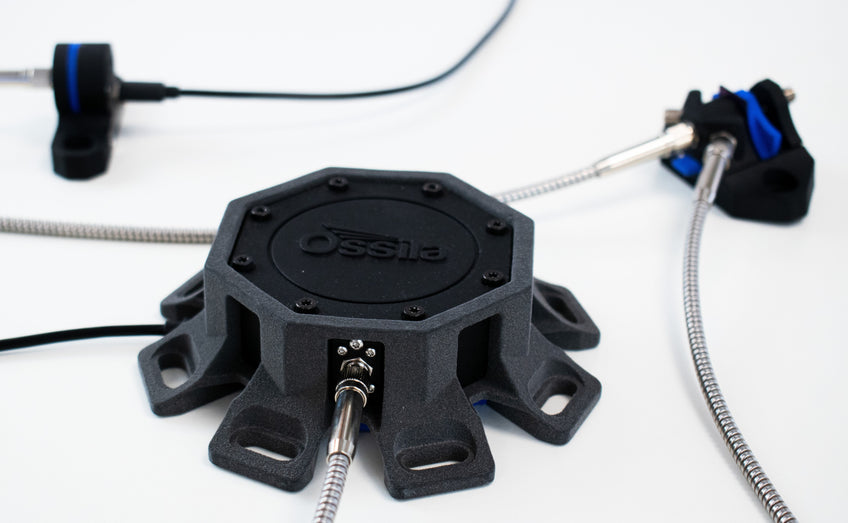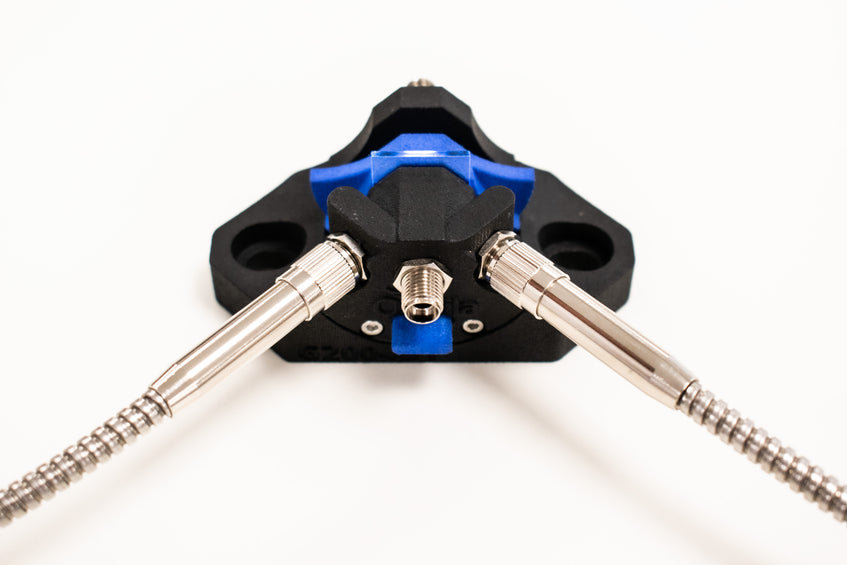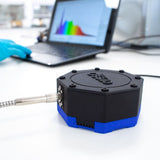Thin Film Fluorescence Measurement

Fluorescence occurs when photons are emitted from a material when stimulated by another photon. Fluorescence measurements are often taken in solution to isolate molecular behavior - but sometimes you need to measure fluorescence of a material as a solid or as a thin film, to inspect its true behavior in a device.
You can use optical spectroscopy as a quick and easy way to characterize fluorescence from a thin film sample. The Ossila USB Spectrometer allows you to detect light between 360 nm - 1000 nm. However, you will need an integrating sphere or a more complex system if you want to measure quantitative measurements such as PLQY.
Your material will emit fluorescence in all directions so there are a number of ways that you can set up your spectroscopy system when measuring fluorescence from a thin film.Some things to consider include:
- When measuring fluorescence from thin films, you must account for incident light reflecting off your sample - especially if you are using a specular substrate such as smooth glass.
- It is important to note that excitation light sources may also travel through your sample, which will also affect your measurement.
- You will also have to consider how strongly your sample will fluoresce and how much of this intensity you can afford to lose.

To measure the fluorescence of a thin film, you will need an optical spectrometer, a fixed sample holder, and a high-energy light source (such as a UV laser or the Ossila UV light source). We also recommend using optical fiber cables between modular elements to reduce the attenuation of your signal. You can take fluorescence measurements through air alone; however, you will need to use some sort of filter to remove the excitation signal. Here, we discuss some of the possible arrangements of your modular elements in order to take fluorescence measurements of thin films.
USB Spectrometer

Measurement Angle
In order to excite electrons into a higher energy state, you must choose a high energy light source to illuminate your sample. However, when you measure thin films (especially if they are on a glass substrate), you need to consider that both the transmission and reflection of the excitation light may affect your measurement. Because of this, the angle that you take your fluorescence measurement at can make a substantial difference to your measured spectrum.
The graph above shows a fluorescence spectra measured from PFO (F8) films and deposited on quartz substrates. Here, we varied the angles between the incident and measured light using the Ossila UV light source (which is included with the Ossila Optical Spectroscopy Kit) and the Ossila 4-port Spectroscopy Transmission Holder. We also used optical fibers between each element to increase the signal-to-noise ratio. You can see from this graph that the measured spectrum is substantially different at each angle. All these spectra have the same measurement variables in order to make them comparable.

The first measurement angle that we tried was at 180° and it was taken straight through the sample as you would do for absorbance measurements. However, you can see in the spectral graphs that any fluorescence signal at this angle was swamped by the excitation source (at 360 nm). This explains the big signal seen at 360 nm. You can see a small amount of fluorescence in the inset figure. To attempt to resolve this, we increased the integration time of the measurement; however, we quickly received the "Intensity Signal Threshold Reached" error message. If you measure samples at this angle, the intensity threshold must be low in order to avoid this error.

In order to negate the transmission of the excitation signal, we tried taking a measurement at a 90° angle to the excitation source. This method can be successful in reducing the excitation signal, but your measurement will still be swamped. At this angle, we found that there was a large amount of specular reflection due to reflection off the quartz substrate (you can see some fluorescence on the graph when you zoom in). However, as in the case of the 180° arrangement, the integration time you can use is limited by an intensity warning.

We found that the ideal angle for taking fluorescence measurements was at 45° from the excitation source. Here, there was a minimal amount of reflection, and due to the low levels of excitation signal, we could increase the integration time to get a higher signal intensity and more accurately measure PFO fluorescence. You can notice all of this on the graph above.
The graph below shows the optimized fluorescence measurements as taken using the Ossila Optical Spectrometer, optical fibers, 4-port spectroscopy sample holder and UV light source.
Longpass Filters
Another way that you can get rid of the excitation signal is to use broadband filters. These will allow you to set up your sample in a 180° or 90° configuration without your spectrum being flooded by the incident light source. Longpass filters (or long pass edge filters) only transmit light above a certain wavelength. Therefore, you must select a filter that removes your excitation source (as completely as possible) while transmitting your measurement signal. It is also important that you place the filter in between the sample and spectrometer, so you allow your sample to be excited in the first place.

For some samples, this may present a problem. For example, we decided to use a 495 nm long pass filter to remove all traces of the excitation source when we took PL measurements of PFO at a 180° angle. This was successful in blocking the excitation signal; however, several of the PFO peaks (at 430 nm and 460 nm) were below this angle and so were cut off from the measurement.
USB Spectrometer

Learn More
 Thin Film Spectroscopy: Setup and Measurement
Thin Film Spectroscopy: Setup and Measurement
You can use your optical spectrometer to measure the absorbance and transmission of visible light through thin films. You can also measure other properties of thin films using this technique, such as photoluminescence. The Ossila Optical Spectroscopy Kit comes with everything you need in order to conduct these measurements on thin films. This article contains some advice from our researchers that should help you get started taking optical spectroscopy measurements of thin films.
Read more... Choosing A Light Source For Your Spectrometer
Choosing A Light Source For Your Spectrometer
Depending on your spectrometer application, you will probably need at least one illumination or excitation source. For electroluminescence measurements will require of some sort of testing board connected to an external voltage source. However, most characterization of optical materials require some sort of incident light. The light source you will need depends on the measurements you are doing.
Read more...